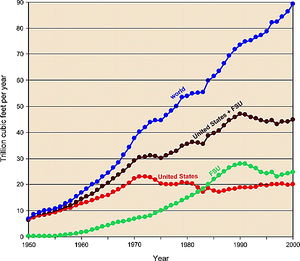Natural gas: history and forecast
Natural gas, a clean-burning, abundant fuel that is capable of highly efficient electric power generation, is now generally acclaimed as the fuel of the future, the fuel of choice, and it might very well be. It is expected to overtake and pass oil as a source of energy early in the 21st century. However, this was not always true. Although gas is said to have been used in China as far back as 200 B.C.,[1] until as recently as 1960, natural gas was regarded as a nuisance, a less-valued by-product of crude oil exploration and production to be gotten rid of as cheaply as possible, commonly by venting it to the atmosphere or by flaring it. Exploratory drilling for natural gas was not seriously considered, and finding gas when searching for oil was commonly considered a calamity.
The main reasons for this lack of interest in discovering and producing natural gas were the low price of gas and the difficulty and high cost of transporting and distributing it. Natural gas can only be transported through pipelines or in liquefied form in special, very expensive cryogenic tankers. There was little incentive, therefore, to discover and produce natural gas if considerable distance separated the natural-gas deposits from the centers of consumption, and such was certainly the case for what we now know are some of the largest accumulations of natural gas in the world, in the former Soviet Union (FSU) and in the Persian Gulf region. During the 1950s, only in the United States was natural gas produced, transported, and consumed in substantial amounts. In 1950, the United States accounted for 90% of the world's natural-gas production and was still producing 75% of the world's total in 1960.[2]

As shown in Figure 1, the picture has changed dramatically in the last two or three decades as demand for natural gas has greatly increased: (1) markets for natural gas have developed in Europe, Japan, and elsewhere; (2) more gas was needed to be reinjected in oil fields in an advanced state of depletion; (3) the technologies of gas liquefaction and pipeline construction have improved, lowering the cost of long-distance natural gas transportation; and (4) environmental consciousness has become an important issue in the energy policy agenda, particularly in the developed world. Natural gas has indeed become the fuel of choice in most energy markets worldwide, particularly in the power-generation sector, where gas has been able to compete successfully with coal and has become the chosen fuel for the majority of new electric power-generating plants using combined-cycle gas turbines. Natural gas has been found to be clean, cost-competitive, and plentiful.
Still, as late as the late 1980s, 88% of all natural gas produced in the world was consumed in the country in which it was produced. Even as of 2005, transportation, instead of discovery and production, remains the key factor in the development of the natural-gas industry. Large volumes of potential natural-gas production still remain stranded for lack of commercial transportation to centers of consumption.
Forecasts for the increasing production and use of natural gas are generally glowing, but the challenges to reach these objectives are still formidable. In addition to transportation, most important perhaps are the large capital requirements and the need for technological developments that would result in cost reductions to ensure competitiveness with alternative energy sources. The development of close internal cooperation between all components of the world natural-gas industry to be able to make possible the construction of large-diameter pipelines that need to cross international borders will also be critical.
See also
References
- ↑ Meyerhoff, A. A., 1980, Proved and ultimate reserves of natural gas and natural gas liquids in the world: Proceedings of the 10th World Petroleum Congress (Bucharest, 1979), v. 2 (exploration, supply, and demand), p. 303-311.
- ↑ Masters, C. D., 1993, World resources of natural gas-A discussion, in D. G. Howel, ed., The future of energy gases: U.S. Geological Survey Professional Paper 1570, p. 607-616.
- ↑ Salvador, A., 2005, Energy-A historical perspective and 21st century forecast: AAPG Studies in Geology 54, 208 p.